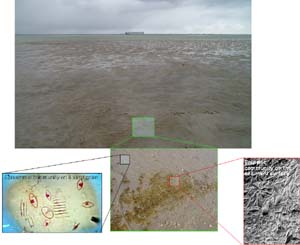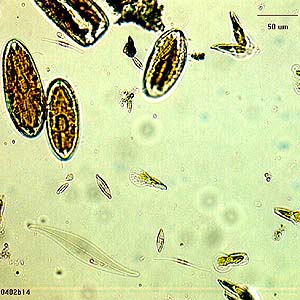Unravelling the relationship between biological diversity and
ecosystem processes on the mudflats of a large European estuary
Rodney M. Forster1, Koen Sabbe2 and Veronique
Creach1
1 Netherlands Institute of Ecology, (NIOO-CEME), PO Box 140, 4400 AC
Yerseke, The Netherlands
2 Lab. Protistology & Aquatic Ecology, Dept. Biology, University
of Gent, Krijgslaan 281 - S8, B-9000 Gent - Belgium
(contact r.forster@nioo.knaw.nl)
Keywords - estuaries, mudflats, biodiversity, biogeochemical cycles,
ecosystem function, land use, impacts, microphytobenthos
Valuable natural real estate In the new discipline of environmental
economics, conventional accounting techniques are used to calculate the
value of natural systems to humankind. Ecosystem functions such as food
production and water regulation, and natural capital stocks, are given
an economic value. This approach, although controversial, gives a
ranking of ecosystems which may be useful for conservation purposes. The
results of a global analysis by Costanza et al. (1997) showed
that marine systems have a higher economic value than terrestrial
systems, due to their larger surface area (Figure 1). Within the marine
realm, the coastal zone was ranked more important than the open oceans,
and estuaries were the second most important type of coastal ecosystem.
Indeed, with a total value of $22 832 per hectare, estuaries are the
most valuable ecosystem on the planet.
A hot spot of activity at the land-water boundary Estuaries are rated
with such a high monetary value because of the wealth of diverse
processes which occur in these systems. At the top of the list of these
'ecosystem services' to humans is nutrient cycling. A large amount of
dissolved materials, including industrial and human waste materials, are
carried into the estuary from the surrounding catchment area.
Biogeochemical processes within the water and sediments of an estuary
can rapidly capture and process a large fraction of the incoming
material. Complex organic molecules are degraded to simpler, inorganic
forms which may be released as gases such as CO2 or N2, or transported
to the open sea in the form of plant nutrients such as nitrate.
A well-stocked larder The diversity and abundance of microbial life
within estuaries provide an important food source for commercially
important species, particularly shellfish. Many species of birds depend
on the rich food supply of estuarine mudflats and marshes for refuelling
during migration, and shallow areas of estuaries are of great importance
for the juvenile stages of fish species such as the herring and sole.
 |
Figure 1. Total global flow value (1994 US $
yr-1 x 109). Click on image to enlarge.
Microscopic life - unseen, but powering the ecosystem Many ecosystem
services within estuaries are enhanced or modified by the presence of
biofilms. These are thin layers of microscopic cells which colonise
intertidal or subtidal sediment surfaces. The majority of the cells in a
biofilm are photosynthetic - i.e. they use special pigments to capture
the energy of sunlight for growth, just like land plants. Over a half of
the primary production in estuaries is due to these microphytobenthic
algae. The most common group of cells are the diatoms, a diverse algal
group which can be found in all aquatic habitats. At certain times of
the year, the diatom biofilms become thick enough to be visible to our
eyes as a brown film on the sediment surface. Not surprisingly, such
'blooms' of microphytobenthos are often accompanied by large flocks of
birds which feed either on the algae directly [e.g. the shellduck, Tadorna
tadorna], or on the animal grazers [e.g. the avocet Recurvirostra
avosetta]. Different waders have different techniques for sieving
animal morsels from the soft matrix of algae and sediment.
Diatoms - key players in coastal ecology Intertidal benthic diatom
communities are highly diverse, both with respect to their taxonomic
composition as well as to the spectrum of growth forms present. To date,
most studies on estuarine and marine microphytobenthos have focused on
the epipelon, which comprises motile pennate diatoms capable of vertical
migration in the upper layers of the sediment. They often represent the
bulk of the autotrophic biomass and primary production, and play a major
role in sediment stabilization through their overproduction of
photosynthetic sugars. These substances are excreted and act as a kind
of glue which binds sediment particles together. However, far less is
known about the biology of the epipsammon, which consists of small
species that are attached to sand grains, and the tychoplanktonic
component (cells which can grow both in the water and on the sediment).
These groups are dominant in sandy and very silty sediments
respectively.
 |
Figure 2. A bloom of microscopic diatoms
colurs the surface of a mudflat in the Schelde estuary in the
Netherlands. (Click on image to enlarge).
Taxonomic diversity in estuarine benthic microphytobenthos is high:
excluding imported planktonic and riverine taxa, about 200 taxa were
observed in a study of the Westerschelde estuary (The Netherlands).
Individual samples contain between 27 and 59 taxa. Due to the
inaccessible nature of mudflats, many habitats in this estuary have not
yet been sampled, so the true number of benthic diatom species in the
Westerschelde estuary is almost certainly higher. Biodiversity and
ecosystem function From a functional point of view, it is intriguing
that despite their local co-occurrence, the diversity and dynamics of
epipelon, epipsammon and tychoplankton appear to be regulated by
different processes. Epipelic communities are less diverse than
epipsammic communities, and show distinct seasonal succession patterns,
with a pronounced spring bloom followed by a summer decline. Epipsammic
communities are highly even (i.e. biomass is rather evenly distributed
over the species present) and have a remarkably stable species
composition throughout the year. Like the epipsammon, the enigmatic
tychoplankton displays a stable composition throughout the year. Very
little is known about the exact life strategies of epipelic, epipsammic
and tychoplanktonic diatoms, but it can be expected that they display
great variation in photosynthetic, trophic, survival and reproductive
strategies, and hence offer great prospects for studying evolutionary
adaptations for survival in the highly dynamic benthic environment. The
roles of the different microphytobenthic functional groups in the
ecology of the Schelde estuary are now under investigation by scientists
from the Netherlands Institute of Ecology, the University of Ghent, and
the Technical University of Delft.
With funding from the European Union and from both Dutch and Flemish
Academies of Sciences, our primary goal is to quantify the biomass and
primary production of microphytobenthic algae throughout the estuary at
different times of year, as these parameters are critical to many
ecosystem services such as nutrient exchange and sediment stabilisation.
Estimates of the concentration of benthic microalgae can now be made
from the air, using hyperspectral sensors which are sensitive to the
wavelengths reflected by algal pigments. Airborne surveys accurately
reveal the location of the most productive intertidal areas, and these
sites are investigated further by ground teams. Another optical
technique, chlorophyll fluorescence, is used to monitor microalgal
photosynthesis in real time. Samples of the sediment surface are then
collected and analysed in the laboratory for nutrient concentrations and
physical properties. At each collection site, microalgal species are
identified using a combination of classical taxonomy (microscopy,
isolation into culture) and molecular biological techniques (DNA
extraction and sequencing). By comparing the functional data with
biodiversity indicators, the 'keystone' species for estuarine ecosystem
vitality can be identified.
 |
New insights on estuarine processes With one of the largest wading
bird populations in western Europe, and several rare habitat types such
as freshwater tidal marshes, the Schelde estuary is a site of
international recognition and importance. The estuary is also a site of
heavy industry, and is an important commercial shipping transport route,
thus coastal zone managers must constantly balance the demands of many
conflicting interest groups. Better knowledge of benthic microalgal
processes, and the contribution of individual species to these
processes, will increase our understanding of the Schelde and other
estuarine ecosystems. In the long term, our results may enable
predictions to be made as to the functional response of estuaries to
climate change, to loss of biodiversity, or to changes in land and water
management practices.
|
